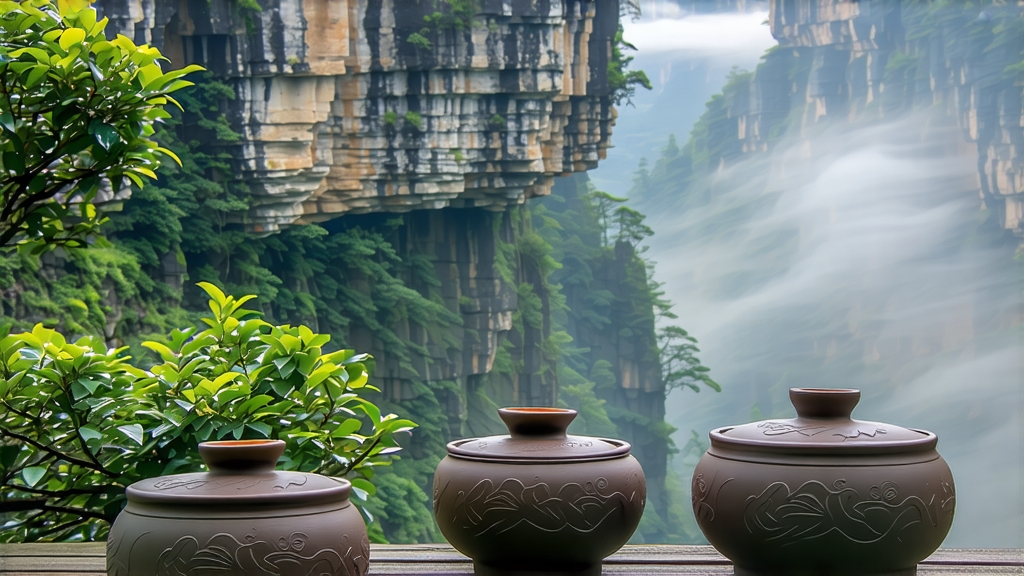
When Chinese tea lovers speak of “rock rhyme”—the stony, mineral whisper that lingers after swallowing an oolong—they are almost always talking about Da Hong Pao, the legendary Scarlet Robe from the Wuyi Mountains of northern Fujian. Few teas carry as much romance, imperial folklore, and sensory complexity in every twisted leaf. To understand Da Hong Pao is to step into a world where myth, geology, and human craftsmanship converge in a single cup.
-
Myth and Memory
The name “Big Red Robe” first appeared in Ming-dynasty gazetteers. Local monks tell of a scholar who, while hurrying to the capital for the imperial exam, collapsed outside the Jiulongke (Nine-Dragon Cave) monastery. The abbot revived him with a brew made from tea bushes rooted in the cliff crevices above. The scholar went on to place first in the palace examination; to express gratitude he returned in crimson official robes and draped them over the bushes, giving the tea its enduring name. Whether apocryphal or not, the story captures the reverence these bushes inspired: even emperors sent officers to harvest them, and the Qing court listed Wuyi tea among its eight tribute items. -
Geography: The Danxia Stone Forest
Wuyi’s Danxia landforms—purple-red sandstone and conglomerate shaped by 100 million years of weathering—create knife-edge cliffs, hidden valleys, and a microclimate of warm days and cool, fog-laden nights. The mineral-rich substrate forces the tea roots to struggle, concentrating aromatic compounds. Locals call this terroir “yan gu”—rock bone—and believe it imparts the unmistakable wet-stone, flinty note that distinguishes authentic Wuyi yancha (cliff tea) from any other oolong on earth. -
Varietal Lineage
Da Hong Pao is not a single cultivar but a stylistic benchmark. Three genetic lines exist:a. Qi Dan – Cuttings taken directly from the six “mother” bushes still clinging to Tianxin Rock. Less than 400 g are harvested yearly; most is archived by the state.
b. Bei Dou No. 1 – A 1960s grafting program that cloned the mother bushes onto lower-elevation farms while preserving their DNA fingerprint.
c. Commercial blends – Skillful mixers combine three or four Wuyi cultivars (often Rou Gui, Shui Xian, and Tie Luo Han) to approximate the mother bush profile when pure Qi Dan is unavailable.
Understanding which version you are buying is essential: Qi Dan offers electric precision, Bei Dou balances accessibility with pedigree, while expert blends can be delicious yet stylistically broader.
-
Craft: The Eight-Stage Cliff Art
After picking the standard three- to four-leaf late-April pluck, leaves undergo:- Solar withering – Spread on bamboo screens for 30–40 min to soften cells.
- Indoor withering – Shaken every hour through the night to bruise edges, initiating oxidation.
- Heat kill-green – 250 °C for 7 min in a tumbling cylinder to halt enzymes at 30 % oxidation, the sweet spot for yancha.
- Rolling – Twice through mechanical rollers to twist leaves into the trademark “dragonfly head” shape.
- Initial roast – 100 °C for 2 h over local Masson-pine charcoal to reduce moisture to 20 %.
- Sorting – Stems and yellow flakes removed by hand.
- Secondary roast – 80 °C for 4 h, rested 20 days, then a final 60 °C “foot fire” for 6 h, deepening the honey-char aroma.
- Aging rest – At least 90 days before sale, allowing the fierce fire to subside into rounded complexity.
A master roaster judges temperature by spreading ash with a horse-tail brush; one mis-timed minute can swing the tea from caramel bliss to bitter tar.
- Flavor Lexicon
First infusions deliver orchid, toasted almond, and a lick of citrus peel. Mid-session steeps unveil wet slate, cinnamon bark, and a cooling camphor finish that Chinese tasters call “hui gan”—returning sweetness. The throat feels coated yet dry,